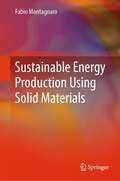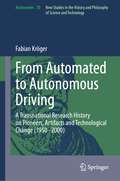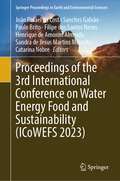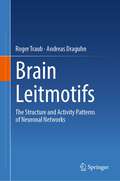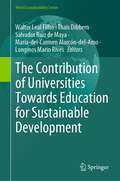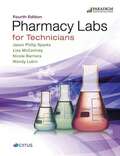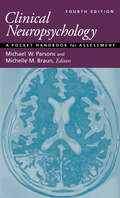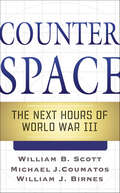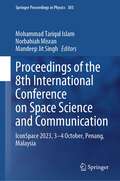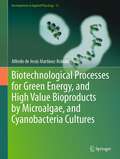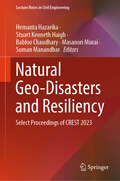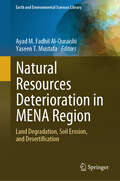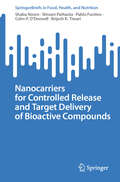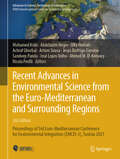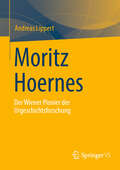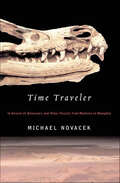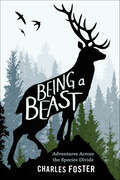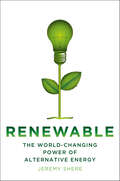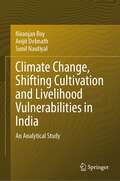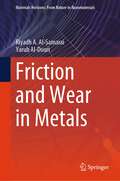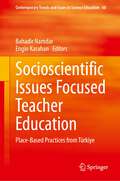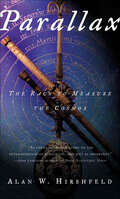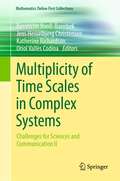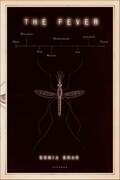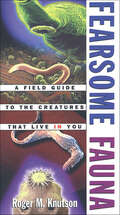- Table View
- List View
Sustainable Energy Production Using Solid Materials
by Fabio MontagnaroThis textbook focuses on sustainable energy production using solid materials. With explanatory tables and figures, case studies, worked-out examples, and up-to-date bibliographies of other works, the book provides an in-depth exploration of the most innovative aspects of the field.Readers of the book will gain critical skills in characterizing and reacting to biomass, including the formation of pollutants, as well as using fluidized bed reactors for heterogeneous processes. The book also explores innovative methods for mitigating the greenhouse effect, reusing ashes as adsorbents or in cement production, and thermochemical solar energy storage. This book will give students, novice researchers, and industry professionals valuable insights and knowledge into the sustainable production of energy using solid materials.
From Automated to Autonomous Driving: A Transnational Research History on Pioneers, Artifacts and Technological Change (1950-2000) (Archimedes #70)
by Fabian KrögerThis book presents the most important milestones of the research on automated and autonomous driving in the United States, Japan and Europe throughout five decades (1950-2000). Drawing on sources from the automotive industry, electrical engineering, the robotics and AI-domain and military institutions, it retraces the transition from the guidance-cable approach to vehicle-based sensor and vision systems. Giving a detailed overview of the technical concepts, artefacts, research vehicles and robots, the book presents the transnational engineering efforts that started long before Silicon Valley entered the field. In addition, the book also uniquely details the role of the military in the domain of vehicle automation. This all ensures the book is of great interest to historians of technology, practitioners in engineering disciplines, scholars working in mobility studies, journalists, and political decision makers.
Proceedings of the 3rd International Conference on Water Energy Food and Sustainability (Springer Proceedings in Earth and Environmental Sciences)
by João Rafael da Costa Sanches Galvão Paulo Brito Filipe dos Santos Neves Henrique de Amorim Almeida Sandra de Jesus Martins Mourato Catarina NobreThis book presents some of the work presented at the 3rd International Conference on Water Energy Food and Sustainability—ICoWEFS 2023, with topics delving into critical global themes. Encompassing four pivotal domains—Water and Circular Economy, Energy, Agrifood, and Sustainability—this book covers cutting-edge research and innovative solutions. Within the ambit of Water and Circular Economy, the discussions span from the sustainable management of water resources, urban and industrial water consumption, to the challenges in governance and the impact of climate change. The Energy section covers chapters on energy production, urban and industrial systems, governance challenges, and the imperative transition toward circular economies. The Agrifood domain probes into sustainable agricultural practices, harnessing smart technologies in farming, climate change's effect on food production, and innovations in food processing. Lastly, the Sustainability segment encompasses a wide array of topics including bioeconomy sustainability, cyber-physical systems, climate change impacts, and resource efficiency, underpinning the urgent need for a holistic approach to global sustainability.
Brain Leitmotifs: The Structure and Activity Patterns of Neuronal Networks
by Roger Traub Andreas DraguhnThis book tackles the question of why the brain is so difficult to fully understand. In neuroscience, data are acquired and analyzed with astonishing techniques and accumulate rapidly. Nevertheless, try to explain how a person can think or why there is such a condition as schizophrenia, and it appears that we really know little. To approach these difficulties, the authors first present a number of case studies in which the operation of a neural circuit is worked out in some detail and, at the same time, the functional significance of the operation is also understood. These examples are complicated in their biologic specifics but are conceptually straightforward. The examples are hoped to provoke an appreciation for what neuroscience can accomplish. The authors then develop some thoughts on how these issues can be addressed----instead of considering cognition in general, taking instead a subset of cognition that does lend itself to formal description.
The Contribution of Universities Towards Education for Sustainable Development (World Sustainability Series)
by Walter Leal Filho Thais Dibbern Salvador Ruiz de Maya María-del-Carmen Alarcón-del-Amo Longinos Marin RivesThe book gathers inputs from universities and research organizations working on matters related to sustainable development in a variety of contexts. It also provides a platform for the dissemination of information on the latest initiatives, paving the way for technology transfer and networking. Furthermore, the book intends to provide a fertile basis upon which universities may cooperate more closely in this key area. Universities, as centers of education, research, and innovation, have a unique position and responsibility in promoting sustainability. They can offer degree programs, courses, and workshops focused on sustainability, environmental studies, and related fields, educating students and the wider community about the principles and challenges of sustainability. Also, universities can conduct cutting-edge research to address sustainability challenges, such as climate change, resource depletion, and biodiversity loss. They can develop innovative technologies and solutions that promote sustainable practices in various sectors, including energy, agriculture, transportation, and urban planning. There is a perceived need to better understand and engage universities further on sustainability initiatives. Against this backdrop and in order to facilitate a broad discussion on the contribution of universities toward sustainability, this book is being produced.Last but not least, a further aim of the book is to present methodological approaches and experiences deriving from case studies and projects, which aim to show how sustainability may be incorporated as part of university programs.
Pharmacy Labs for Technicians
by Jason Philip Sparks Lisa McCartney Nicole Barriera Wendy LubinPharmacy Labs for Technicians, Second Edition teaches students detailed lab procedures and skills using hands-on practice. Included are 34 labs that teach administrative and clinical procedures such as using pharmacy reference texts, filling prescriptions, compounding medications, and preparing sterile intravenous products.
Clinical Neuropsychology: A Pocket Handbook for Assessment
by Michael W. Parsons Michelle M. BraunFully revised and updated, this pocket handbook for clinical assessment covers a comprehensive range of neurological, neuropsychological, neuropsychiatric, and neurobehavioral syndromes and disorders. Now in its fourth edition, this ready reference helps the busy clinician or doctoral-level trainee select from among hundreds of tests and assessment techniques in clinical neuropsychology. It guides clinicians in developing tailored, hypothesis-driven approaches for assessing patients with a broad range of common neuropsychological syndromes and neurological disorders. This book is an invaluable diagnostic guide designed to fit into a lab coat pocket for accessible and immediate use. Major updates to the new edition include: A revamped approach to contemporary neuropsychological assessment that incorporates cultural factors, mood, emotion and affect, medications, cognitive functioning and electrophysiology data, as well as emerging trends including tele-neuropsychology, positive neuropsychology, and consumer‑focused reports. New and expanded coverage of topics including updates on neurodegenerative disorders and mild cognitive impairment (MCI); lifestyle interventions to maximize cognitive functioning in MCI and dementia; chronic traumatic encephalopathy (CTE), autoimmune disorders, and motor disorders. An increased emphasis on neuropsychiatric syndromes. New topics include intellectual disabilities, the impact of marijuana and alcohol on cognitive functioning, anxiety disorders/PTSD, and an expanded focus on mood disorders. Updated online resources to support teaching and learning through neuroimaging figures and video demonstrations of exam techniques, and extended reading lists that have been expanded and more fully integrated into assessment chapters.
Counterspace: The Next Hours of World War III
by William B. Scott Michael J. Coumatos William J. BirnesIn Space Wars, Scott, Coumatos, and Birnes created a fascinating war gaming scenario of how World War III might unfold in above the Earth's surface. Now this thrilling team of writers reunites with Counterspace, an even more chilling fictionalized look at America's most catastrophic fears. What if North Korea detonated a nuclear weapon in space and silenced dozens of satellites? What if an Iranian missile threatened to destroy Israel, while a Venezuelan "research" satellite endangered one of the US's most promising space initiatives?What if tech-savvy terrorist cells unleashed back-to-back horrors in California, creating an avalanche of crises overnight, as national leaders robbed of spy satellite imagery were forced to make decisions in the "blind"?These are the scenarios of Counterspace, a frighteningly plausible look at threats to the United States and the world. Scott, Coumatos, and Birnes use war gaming scenarios to show how the US Strategic Command might choose to fight off these menaces and prevent global disaster. Combining current and future technology with our enemies' grandest plans, Counterspace is equally a terrifying possibility and a hopeful affirmation that America can and will be ready to face such dangers, told with the pulse-pounding power of a modern day thriller.At the Publisher's request, this title is being sold without Digital Rights Management Software (DRM) applied.
Proceedings of the 8th International Conference on Space Science and Communication: IconSpace 2023, 3–4 October, Penang, Malaysia (Springer Proceedings in Physics #303)
by Mohammad Tariqul Islam Norbahiah Misran Mandeep Jit SinghThis book presents peer-reviewed articles from the 8th International Conference on Space Science and Communication (IConSpace 2023), held at Penang in Malaysia. It addresses complications of ground-breaking initiatives and solutions for space science and communications research, telecommunications, and meteorology. With the theme Advanced Space Technology: Accelerating Global Agenda will provide valid information to understand trends, evaluate needs, and create global development policies and programs in the best interest of all. It brings together researchers, engineers, geospatialist, meteorologists, astronomers, and practitioners in order to present the latest applications in space science, telecommunications, meteorology, remote sensing, and related fields.
Biotechnological Processes for Green Energy, and High Value Bioproducts by Microalgae, and Cyanobacteria Cultures (Developments in Applied Phycology #13)
by Alfredo de Jesús Martínez-RoldánMicroalgae and cyanobacteria are a very diverse group of photosynthetic microorganisms with many applications. Some of them are related to the accumulation of molecules involved in specific metabolic pathways such as pigments, fatty acids, polyunsaturated fatty acids, carbohydrates, amino acids, etc. Also, there are uses of the biomass related to the exploitation of physiological necessities such as the absorption of essential nutrients (the removal of nitrogen and phosphorus from wastewater, the capture of CO2 from the fixation of nitrogen, etc.). Nevertheless, the evaluation in financial and life-cycle aspects is necessary to ensure the industrial application of the processes. The objective of the book is to analyze innovative applications of microalgae and cyanobacteria to develop environmental-friendly processes for removal of pollutants, wastewater treatment, production of high-value products or bioenergy, and finally evaluate the feasibility of the processes both ineconomic and sustainability aspects.
Natural Geo-Disasters and Resiliency: Select Proceedings of CREST 2023 (Lecture Notes in Civil Engineering #445)
by Hemanta Hazarika Stuart Kenneth Haigh Babloo Chaudhary Masanori Murai Suman ManandharThis book presents select proceedings of the 2nd International Conference on Construction Resources for Environmentally Sustainable Technologies (CREST 2023), and focuses on sustainability, promotion of new ideas and innovations in design, construction and maintenance of geotechnical structures with the aim of contributing towards climate change adaptation and disaster resiliency to meet the UN Sustainable Development Goals (SDGs). It presents latest research, information, technological advancement, practical challenges encountered, and solutions adopted in the field of geotechnical engineering for sustainable infrastructure towards climate change adaptation. This volume will be of interest to those in academia and industry alike.
Natural Resources Deterioration in MENA Region: Land Degradation, Soil Erosion, and Desertification (Earth and Environmental Sciences Library)
by Ayad M. Fadhil Al-Quraishi Yaseen T. MustafaLand deterioration, drought, desertification, and water resources shrinkage threaten natural resources, negatively impacting environmental, economic, and political stability. The increasing occurrence of climate change (extremes) impacts land degradation processes, soil erosion by water and wind, and salinization. The researchers have invested several years of scientific research in natural resources deterioration, including soil degradation and erosion, land degradation, desertification, and climate changes, which are interesting enough. However, the link between science and policymaking appears to be less active as serious actions do not take fast. The eighteen chapters of this book focus more on topics related to natural resources deterioration, such as land degradation, desertification, drought, climate change, and analysis of numerous case studies. This book presents experts' overviews, study results, experiences, and knowledge of natural resources deterioration in MENA countries. It attracts researchers, experts, scholars, scientists, academics, students, practitioners, graduates, or anybody interested in land degradation, desertification, climate change, and natural hazards that fall within natural resources deterioration. Therefore, researchers keep continuing to do their investigations and produce results that convince stakeholders and policymaking to act immediately towards protecting natural resources and their sustainability.
Nanocarriers for Controlled Release and Target Delivery of Bioactive Compounds (SpringerBriefs in Food, Health, and Nutrition)
by Shaba Noore Shivani Pathania Pablo Fuciños Colm P. O'Donnell Brijesh K. TiwariThis brief provides a comprehensive overview of nanocarriers used for nanoencapsulation of bioactive compounds. It includes the basis of encapsulation mechanism, encapsulation efficiency, controlled release, target delivery, and its application in food, nutraceuticals, pharmaceuticals and cosmeceuticals.
Recent Advances in Environmental Science from the Euro-Mediterranean and Surrounding Regions: Proceedings of 3rd Euro-Mediterranean Conference for Environmental Integration (EMCEI-3), Tunisia 2021 (Advances in Science, Technology & Innovation)
by Mohamed Ksibi Abdelazim Negm Olfa Hentati Achraf Ghorbal Arturo Sousa Jesus Rodrigo-Comino Sandeep Panda José Lopes Velho Ahmed M. El-Kenawy Nicola PerilliThis edited book includes over one hundred and eighty short papers that were presented during the third edition of EMCEI, which was held in Sousse, Tunisia, in June 2021. Nowadays, experts as well as most of the general public know that the Mediterranean and surrounding regions are facing environmental degradation that is accelerating at an unprecedented rate. The main causes are the natural and human induced climate change, increasing pollution, urban growth, and the overexploitation and unsustainable use of resources due to rapid population growth. The effects are seen in several indicators such as the warming, more frequent extreme events, severe droughts, water shortages, contraction of natural resources, changes in land use and landscape deterioration, decreasing agricultural yields, biodiversity loss, deterioration of the ecosystems, corrosion of the natural coastal environment, sea-level rise, and ocean acidification. In addition to these more recent issues, the Mediterranean and surrounding region naturally experience a number of hazards such as floods, droughts, desertification, fires, catastrophic forest diebacks, earthquakes, and volcanic eruptions. By presenting a wide range of environmental topics and new findings relevant to a variety of problems in these regions, this book appeals to anyone working in the subject area and especially students interested in learning more about new developments in environmental research initiatives in light of the worsening environmental degradation of the Mediterranean and surrounding areas, making environmental and resource protection an increasingly important issue that impedes sustainable development and social well-being. The book addresses emerging environmental issues along with new challenges by focusing on innovative approaches that contribute to achieving a sustainable environment in and around the Mediterranean Sea and by highlighting to decision makers from relevant sectors the environmental considerations that should be integrated into their own activities.
Moritz Hoernes: Pionier der Urgeschichtsforschung
by Andreas LippertDer Band ist eine Biografie des ersten Lehrkanzelinhabers für Prähistorische Archäologie im deutschen Sprachraum. Nach einer längeren Zeit von Forschungen in Bosnien und der Herzegowina fand Hoernes eine Anstellung in der Prähistorischen Sammlung des Naturhistorischen Hofmuseums in Wien. Hier erst entschied er sich für urgeschichtliche Forschungen. Er habilitierte sich für das Fach 1892 und wurde bereits 1899 zum außerordentlichen Univ.-Professor an der Universität Wien ernannt. 1911 erfolgte dann seine Berufung als ordentlicher Univ.-Professor an dieser Universität. Hoernes verfasste einige bedeutende Übersichtswerke zur Urgeschichte in Europa, die noch heute Geltung haben, und zahlreiche Fachbeiträge.
Time Traveler: In Search of Dinosaurs and Other Fossils from Montana to Mongolia
by Michael NovacekHunting for fossils with a preeminent guide and teacherMichael Novacek, a world-renowned paleontologist who has discovered important fossils on virtually every continent, is an authority on patterns of evolution and on the relationships among extinct and extant organisms. Time Traveler is his captivating account of how his boyhood enthusiasm for dinosaurs became a lifelong commitment to vanguard science. He takes us with him as he discovers fossils in his own backyard in Los Angeles, then goes looking for them in the high Andes, the black volcanic mountains of Yemen, and the incredibly rich fossil badlands of the Gobi desert.Wherever Novacek goes he searches for still undiscovered evidence of what life was like on Earth millions of years ago. Along the way he has almost drowned, been stung by deadly scorpions, been held at gunpoint by a renegade army, and nearly choked in raging dust storms. Fieldwork is very demanding in a host of unusual, dramatic, sometimes hilarious ways, and Novacek writes of its alluring perils with affection and discernment. But Time Traveler also makes sense of many complex themes - about dinosaur evolution, continental drift, mass extinctions, new methods for understanding ancient environments, and the evolutionary secrets of DNA in fossil organisms. It is also an enthralling adventure story.
Being a Beast: Adventures Across the Species Divide
by Charles FosterA passionate naturalist explores what it’s really like to be an animal—by living like themHow can we ever be sure that we really know the other? To test the limits of our ability to inhabit lives that are not our own, Charles Foster set out to know the ultimate other: the non-humans, the beasts. And to do that, he tried to be like them, choosing a badger, an otter, a fox, a deer, and a swift. He lived alongside badgers for weeks, sleeping in a sett in a Welsh hillside and eating earthworms, learning to sense the landscape through his nose rather than his eyes. He caught fish in his teeth while swimming like an otter; rooted through London garbage cans as an urban fox; was hunted by bloodhounds as a red deer, nearly dying in the snow. And he followed the swifts on their migration route over the Strait of Gibraltar, discovering himself to be strangely connected to the birds. A lyrical, intimate, and completely radical look at the life of animals—human and other—Being a Beast mingles neuroscience and psychology, nature writing and memoir to cross the boundaries separating the species. It is an extraordinary journey full of thrills and surprises, humor and joy. And, ultimately, it is an inquiry into the human experience in our world, carried out by exploring the full range of the life around us.
Renewable: The World-Changing Power of Alternative Energy
by Jeremy ShereWhere does the energy we use come from? It's absolutely vital to every single thing we do every day, but for most people, it is utterly invisible. Flick a switch and the lights go on. It might as well be magic. Science writer Jeremy Shere shows us in Renewable: The World-Changing Powerof Alternative Energy that energy is anything but magical. Producing it in fossil fuel form is a dirty, expensive—but also hugely profitable— enterprise, with enormous but largely hidden costs to the entire planet. The cold, hard fact is that at some point we will have wrung the planet dry of easily accessible sources of fossil fuel. And when that time comes, humankind will have no choice but to turn—or, more accurately, return—to other, cleaner, renewable energy sources. What will those sources be? How far have we come to realizing the technologies that will make these sources available?To find the answers, Shere began his journey with a tour of a traditional coal-fueled power plant in his home state of Indiana. He then continued on, traveling from coast to coast as he spoke to scientists, scholars and innovators. He immersed himself in the green energy world: visiting a solar farm at Denver's airport, attending the Wind Power Expo and a wind farm tour in Texas, investigating turbines deep in New York City's East River, and much more. Arranged in five parts—Green Gas, Sun, Wind, Earth, and Water—Renewable tells the stories of the most interesting and promising types of renewable energy: namely, biofuel, solar, wind, geothermal, and hydropower. But unlike many books about alternative energy, Renewable is not obsessed with megawatts and tips for building home solar panels. Instead, Shere digs into the rich, surprisingly long histories of these technologies, bringing to life the pioneering scientists, inventors, and visionaries who blazed the way for solar, wind, hydro, and other forms of renewable power, and unearthing the curious involvement of great thinkers like Henry Ford, Thomas Edison, and Nicola Tesla.We are at an important crossroads in the history of renewable technologies. The possibilities are endless and enticing, and it has become increasingly clear that renewable energy is the way of the future. In Renewable, Jeremy Shere's natural curiosity and serious research come together in an entertaining and informative guide to where renewable energy has been, where it is today, and where it's heading.
Climate Change, Shifting Cultivation and Livelihood Vulnerabilities in India: An Analytical Study
by Niranjan Roy Avijit Debnath Sunil NautiyalThis book explores how climate change affects households that rely on shifting cultivation and how to assess their vulnerability. This study looks at micro and macro levels in Indian states with indigenous communities practicing shifting cultivation. The micro-level study has been conducted in 52 villages, with 1469 households covering 7067 population in seven states of India in the Northeastern region. The book covers different topics related to climate change, such as its patterns, impact on households and agriculture, forest management, and the role of indigenous knowledge in mitigation. This research is associated with different sectors like shifting agriculture, forestry sector, climate change and rural development etc. and integrated with large respondents and stakeholders through both direct and focus group discussions. Research scholars, climate activists, institutional and non-institutional organisations, people interested in environmental science, social science and policymakers will find this book very relevant.
Friction and Wear in Metals (Materials Horizons: From Nature to Nanomaterials)
by Riyadh A. Al-Samarai Yarub Al-DouriThis book focuses on tribology in manufacturing processes from the viewpoint of sliding friction fundamentals, the use of lubricants to control friction processes such as machining, drawing, rolling, extrusion, abrasive processes, and processing at micro and nanoscales. To study tribological behavior, it is essential to know the methods of measuring and describing the surface shape and roughness. The friction and wear, their corresponding coefficients, and their main mechanisms are described, including stick-slip effects, adhesion, and plowing. Adhesive, abrasive, erosive, and erosion-corrosion wear mechanisms. Friction–wear relationships are elaborated, and wear maps are presented. Surface interactions depend on the contacting materials and surface shape. It is a function of the production process and nature of parent materials that are found to be rough, where roughness is characterized by asperities of varying amplitudes and spacing. Surface interactions are dependent both on thecontacting materials and the shape of the surface. The distribution of the asperities is directional when the finishing process is direction-dependent, such as turning, milling, etc., and homogeneous for a non-directional finishing process like lapping, electro-polishing.
Socioscientific Issues Focused Teacher Education: Place-Based Practices from Türkiye (Contemporary Trends and Issues in Science Education #60)
by Bahadir Namdar Engin KarahanThis book explores place-based pedagogies in the context of socioscientific issues in Türkiye. From local and global contexts, it delves into research-based learning activities for science teacher educators, offering insights to educators worldwide.The book aims to empower teachers to provide students with learning experiences centered on local socioscientific issues essential for developing scientifically literate citizens. Each chapter showcases effective practices, focusing on local topics like gold mining, nuclear power plants, and river pollution. By incorporating socioscientific elements into science lessons, teachers are encouraged to foster students’ responsibility values, argumentation, critical thinking, and awareness. Emphasizing the crucial components of place-basedness and relevancy of SSI learning environments, students are guided towards more sophisticated ways of conceptualizing and resolving SSI. The intended audience includes science teacher educators, researchers, and educators devoted to engaging students in meaningful socioscientific learning experiences.
Parallax: The Race to Measure the Cosmos (Dover Books On Astronomy Ser.)
by Alan W. HirshfeldIn the dramatic tradition of the best-selling Longitude, Parallax charts the historical path of observational astronomy's most daunting challenge: measuring the distance to a star. The greatest scientific minds applied themselves in vain to the problem across the millennia, beginning with the ancient Greeks. Not until the nineteenth century would three astronomers, armed with the best telescopes of the age, race to conquer this astronomical Everest—their contest ending in a virtual dead heat. Against a sweeping backdrop filled with kidnappings, dramatic rescue, swordplay, madness, and bitter rivalry, Alan Hirshfeld brings to life the heroes of this remarkable story. Meet the destitute boy plucked from a collapsed building who becomes the greatest telescope maker the world has ever seen; the hot-tempered Dane whose nose is lopped off in a duel over mathematics; the merchant's apprentice forced to choose between the lure of money and his passion for astronomy; and the musician who astounds the world by discovering a new planet from his own backyard. Generously illustrated with diagrams, period engravings, and paintings, Parallax is an unforgettable tale that illuminates the distinctly human side of science.
Multiplicity of Time Scales in Complex Systems: Challenges for Sciences and Communication II (Mathematics Online First Collections)
by Bernhelm Booß-Bavnbek Jens Hesselbjerg Christensen Katherine Richardson Oriol Vallès CodinaNote to the interested reader to have a look at the companion to this volume Challenges for Sciences and Communication I | ISBN: 978-3-031-28048-1.This highly interdisciplinary volume brings together a carefully curated set of case studies examining complex systems with multiple time scales (MTS) across a variety of fields: materials science, epidemiology, cell physiology, mathematics, climatology, energy transition planning, ecology, economics, sociology, history, and cultural studies. The book addresses the vast diversity of interacting processes underlying the behaviour of different complex systems, highlighting the multiplicity of characteristic time scales that are a common feature of many and showcases a rich variety of methodologies across disciplinary boundaries. Self-organizing, out-of-equilibrium, ever-evolving systems are ubiquitous in the natural and social world. Examples include the climate, ecosystems, living cells, epidemics, the human brain, and many socio-economic systems across history. Their dynamical behaviour poses great challenges in the pressing context of the climate crisis, since they may involve nonlinearities, feedback loops, and the emergence of spatial-temporal patterns, portrayed by resilience or instability, plasticity or rigidity; bifurcations, thresholds and tipping points; burst-in excitation or slow relaxation, and worlds of other asymptotic behaviour, hysteresis, and resistance to change. Chapters can be read individually by the reader with special interest in such behaviours of particular complex systems or in specific disciplinary perspectives. Read together, however, the case studies, opinion pieces, and meta-studies on MTS systems presented and analysed here combine to give the reader insights that are more than the sum of the book’s individual chapters, as surprising similarities become apparent in seemingly disparate and unconnected systems. MTS systems call into question naïve perceptionsof time and complexity, moving beyond conventional ways of description, analysis, understanding, modelling, numerical prediction, and prescription of the world around us. This edited collection presents new ways of forecasting, introduces new means of control, and – perhaps as the most demanding task – it singles out a sustainable description of an MTS system under observation, offering a more nuanced interpretation of the floods of quantitative data and images made available by high- and low-frequency measurement tools in our unprecedented era of information flows.
The Fever: How Malaria Has Ruled Humankind for 500,000 Years
by Sonia ShahIn recent years, malaria has emerged as a cause célèbre for voguish philanthropists. Bill Gates, Bono, and Laura Bush are only a few of the personalities who have lent their names—and opened their pocketbooks—in hopes of curing the disease. Still, in a time when every emergent disease inspires waves of panic, why aren't we doing more to eradicate one of our oldest foes? And how does a parasitic disease that we've known how to prevent for more than a century still infect 500 million people every year, killing nearly 1 million of them?In The Fever, the journalist Sonia Shah sets out to answer these questions, delivering a timely, inquisitive chronicle of the illness and its influence on human lives. Through the centuries, she finds, we've invested our hopes in a panoply of drugs and technologies, and invariably those hopes have been dashed. From the settling of the New World to the construction of the Panama Canal, through wars and the advances of the Industrial Revolution, Shah tracks malaria's jagged ascent and the tragedies in its wake, revealing a parasite every bit as persistent as the insects that carry it. With distinguished prose and original reporting from Panama, Malawi, Cameroon, India, and elsewhere, The Fever captures the curiously fascinating, devastating history of this long-standing thorn in the side of humanity.
Fearsome Fauna: A Field Guide to the Creatures That Live in You
by Roger M. KnutsonHypochondriacs beware-- would you believe the nastiest creatures in the known universe live inside our bodies? Not content to just find a home and produce offspring in our internal space, parasites will drink our blood, eat our cells, and infest our muscles. There is very little that can be said in their favor, with perhaps one exception-- they are truly fascinating!Fearsome Fauna is a wickedly amusing and startlingly informative look into the secret world of these fascinating creatures. Perhaps the greatest biological success story of all time (there are more kinds of parasites than insects), parasites have found homes in the vast majority of people on earth and have learned to live in their environment without destroying it (usually). For readers who would like to meet these hardworking beasts-- or learn how to avoid them-- Fearsome Fauna tells you everything you always wanted to know about parasites but were too disgusted or terrified to ask.
